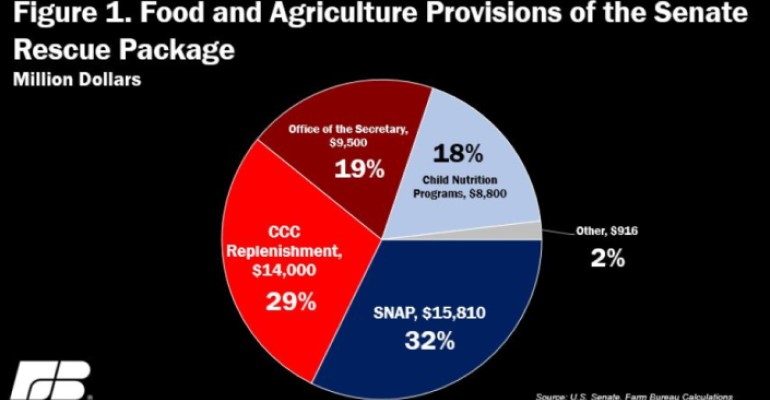
Following the Senate’s unanimous passage late on Wednesday evening, the House of Representatives passed by voice vote on Friday the Coronavirus Aid, Relief, and Economic Security Act. President Trump signed the bill later in the afternoon on Friday in the Oval Office.
Direct food- and agriculture-related provisions in the CARES Act total approximately $49 billion, according to an overview of the spending from American Farm Bureau Federation chief economist John Newton. For the agriculture-related provisions, the Office of the Secretary of the Department of Agriculture received $9.5 billion, approximately 19% of the total food and agriculture provisions, to provide financial support to farmers and ranchers impacted by coronavirus. The funding is allocated specifically for specialty crops, producers who supply local food systems and farmers’ markets, restaurants and schools, livestock producers, i.e., cattlemen and women, and dairy farmers.
In addition to the $9.5 billion, the Commodity Credit Corporation was replenished with $14 billion – 29% of the total funding amount for agriculture. Of the $49 billion in ag funding, 2% of the funding – approximately $916 million – is allocated for enhancing staffing and services in a number of key mission areas.
House Agriculture Committee ranking member Michael Conaway (R., Texas), said in a statement, “Included in this relief package is critical help for our farm and ranch families, who are officially recognized by the U.S. government as critical infrastructure and must keep working in order to keep our grocery shelves stocked. Our farm and ranch families are living up to this charge and getting it done even under the enormous financial strain of seven straight years of economic recession in agriculture.
“As they continue to care for their livestock and head into the fields to plant, I strongly urge the Administration and USDA to work swiftly to get this much needed aid to our nation’s farmers and ranchers without delay. If this legislation is to succeed in bolstering the economy, the overriding goal must be to get aid to all Americans as quickly as possible, including farmers, ranchers, and rural America,” Conaway added.
Agricultural Retailers Association (ARA) President and CEO Daren Coppock said following the House vote ARA is pleased with the support that Congress has included for the agriculture industry in this bill. “Ag retailers and their farmer customers, as always, are committed to continuing their businesses so that they can deliver the safe, healthy, and abundant food supply that is in demand now and required for the future.
Michael Dykes, D.V.M., president and CEO of the International Dairy Foods Assn., said, “On behalf of America’s dairy industry, IDFA is grateful that this bipartisan bill has put a special emphasis on businesses large and small, farmers, and our rural communities who grow, process and distribute many of the foods and beverages that are so vital to Americans during this crisis.”
Dykes urged Congress to continue to be mindful of the critical part the food industry plays in our national security, economic security and food security. The United States is the world’s most productive food and agricultural economy in the world, and our legislators and federal officials must do everything in their power to ensure continuity of operations throughout the food supply chain. Our food security is absolutely essential.
The CARES Act includes billions of dollars to support federal nutrition and feeding programs, as well as $450 million for USDA to provide food banks with additional resources for food and distribution. “With resources in place through replenishment of the Commodity Credit Corporation, billions for nutrition and feeding programs, and millions to support our food banks, it is incumbent on USDA to act without delay,” Dykes noted.
“We urge USDA to act today to make record purchases of fluid and powdered milk, cheese, and other dairy products, as well as other foods and commodities, to equip our food banks for a surge of food-insecure Americans and to bring certainty and balance to the marketplace due to whole sectors of the economy shutting down due to COVID-19,” he said.
“The closure of restaurants, cafes, bars and other food service operators as a result of COVID-19 has created a major market gap for our dairy producers and processors. While retail sales have climbed steadily, the loss of foodservice, which accounted for roughly 50% of all food sales, has presented a significant challenge to our industry. USDA should act now to direct those products to food banks to help people in need. This will prioritize those most in need, provide certainty to producers and agribusinesses, and restore needed balance in the marketplace.”
About the Author(s)
You May Also Like






